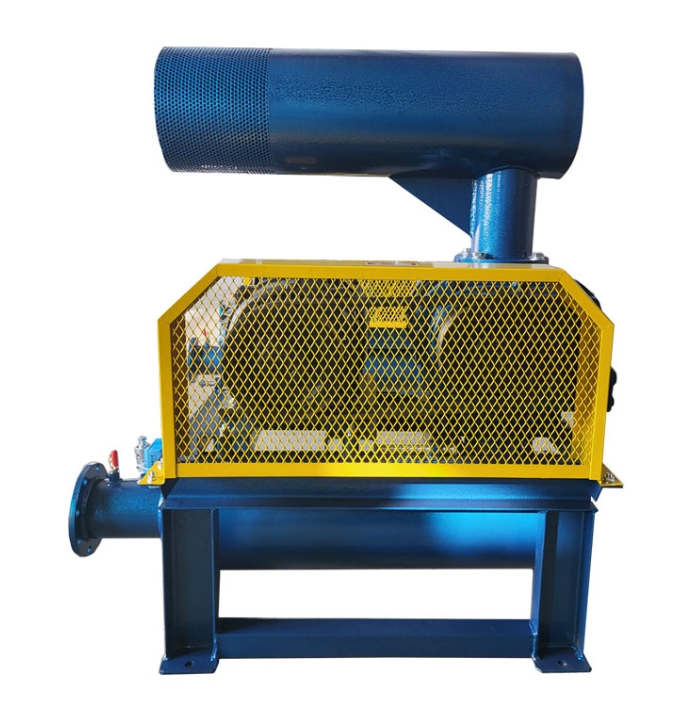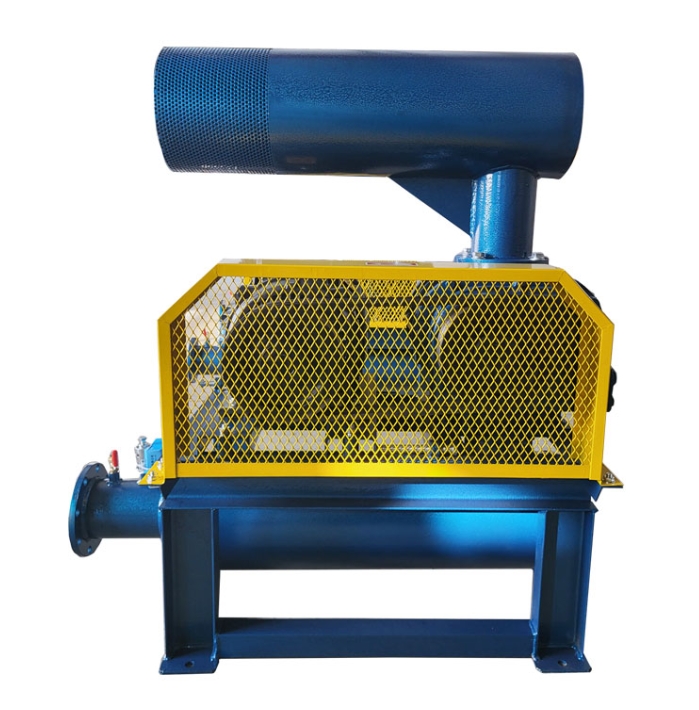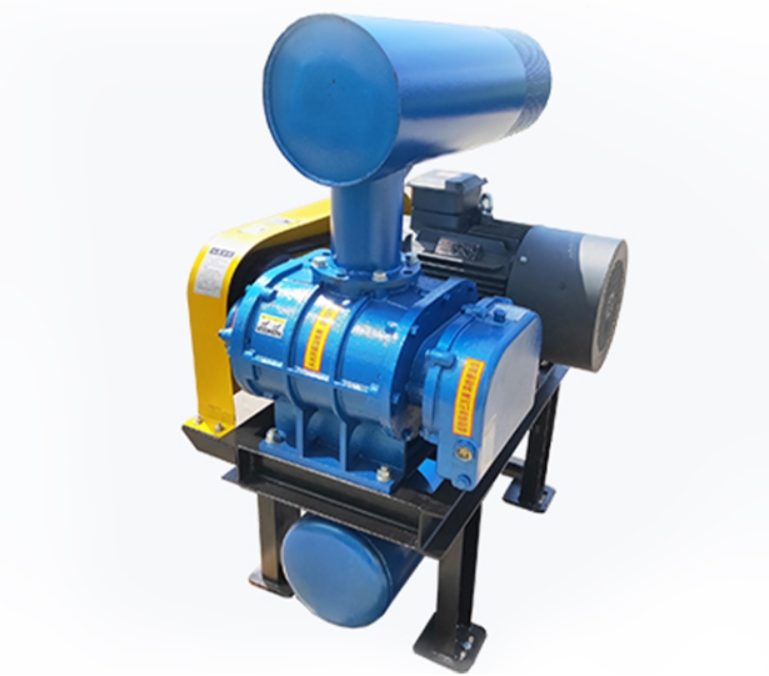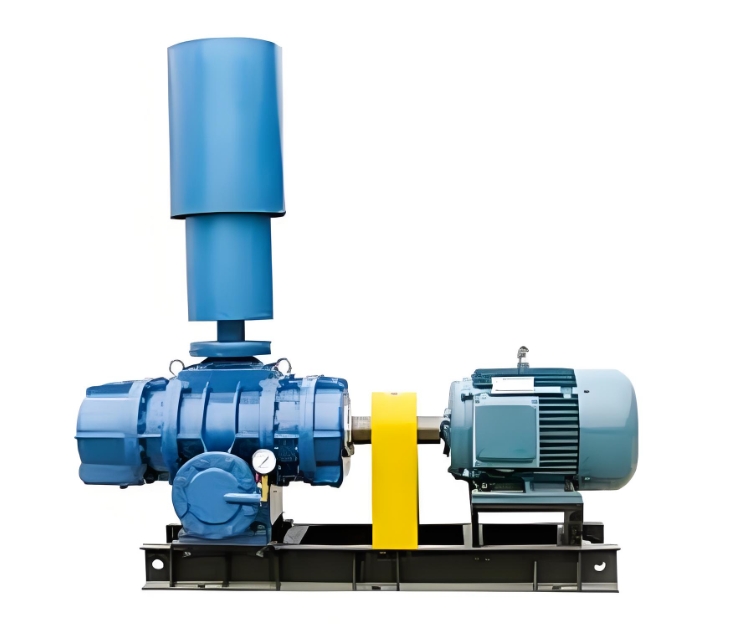The * * air volume (flow rate) * * and * * air pressure (pressure) * * of Roots blower are its core performance parameters, which directly affect the selection and use effect. Here is a detailed analysis:
---

**1、 Airflow (flow rate)**
**1. Definition and Unit**
-Definition: The volume of gas transported by a fan per unit time (usually referring to standard conditions: 20 ℃, 101.325 kPa).
-* * Unit * *: m3/min (commonly used) m3/h、L/s。
**2. Influencing factors**
-Speed * *: The air volume is approximately proportional to the speed (speed ↑ → air volume ↑).
-Impeller size: The larger the diameter and length of the impeller, the greater the airflow.
-Volumetric efficiency: affected by the clearance between the impeller and the casing (clearance ↑ → internal leakage ↑ → actual air volume ↓).
**3. Key selection points**
-* * Calculate required air volume * *:
\[
Q_ {\ text {actual}}=Q_ {\ text {theoretical}} \ times (1+\ text {coefficient}) \ quad (\ text {usually takes 1.1~1.2})
\]
-Example: The oxygen demand of the aeration tank is 10 m3/min, and the selected fan air volume is ≥ 11 m3/min.
-* * Attention * *: High temperature/high altitude requires conversion of operating air volume (gas density changes).
---
**2、 Wind pressure (pressure)**
**1. Definition and Unit**
-Definition: The static pressure difference (non compression ratio) between the outlet and inlet of a fan, which is the ability to overcome pipeline resistance.
-* * Unit * *: kPa、bar(1 bar = 100 kPa)、mmHO(1 kPa ≈ 102 mmHO)。
**2. Influencing factors**
-* * System resistance * *: including pipeline friction resistance, local resistance of bends/valves, and pressure requirements of terminal equipment (such as aeration tank water depth).
-Fan design: The impeller profile and clearance accuracy affect the allowable pressure.
**3. Key selection points**
-* * Calculate system resistance * *:
\[
\Delta P=\ Delta P_ {\ text {pipeline}}+\ Delta P_ {\ text {equipment}}}
\]
-Pipeline resistance: can be estimated through fluid software (such as PipeFlow) or empirical formulas.
-Equipment resistance: If the water depth of the aerator is 4 meters, the required pressure should be ≥ 39.2 kPa.
-Ultimate pressure: The calibration pressure of Roots blower is generally 9.8~98 kPa. For overpressure, screw blower or multi-stage series connection should be selected.
---
**3、 The relationship between air volume and wind pressure**
**1. Performance curve**
-The Roots blower is a positive displacement blower with a constant theoretical air volume, but the actual air volume slightly decreases with increasing pressure (internal leakage increases).
```plaintext
[Example Curve]
Pressure (kPa) | Airflow (m3/min)
0 | 20
49 | 19
98 | 17.5
```
**2. Selection matching**
-Misconception: Believing that increasing pressure can increase air volume - in reality, it is necessary to increase the impeller or speed to increase the air volume.
-* * Correct method * *:
-First, determine the required pressure based on the system resistance.
-Select the model that meets the airflow requirements under the corresponding pressure.
---
**4、 Example of Actual Application Parameters**
|* * Scenario * * | * * Typical Airflow * * | * * Typical Pressure * * | * * Explanation * *|
|------------------|--------------------|--------------------|-------------------------|
|Wastewater treatment aeration | 10-100 m3/min | 39.2-58.8 kPa | Selection based on water depth and aerator|
|Pneumatic conveying (grain) | 5-30 m3/min | 49~78.4 kPa | The longer the conveying distance, the higher the pressure|
|Vacuum feeding | 1-10 m3/min | -49~-78.4 kPa | Negative pressure operation requires vacuum design|
|Boiler combustion assistance | 2~20 m3/min | 9.8~19.6 kPa | Low pressure stable flow is sufficient|
---
**5、 Frequently Asked Questions and Answers**
**Q1: How to adjust the air volume and pressure**
-Wind volume adjustment:
-* * Variable frequency speed regulation * *: scheme, energy-saving and linear adjustment.
-* * Bypass valve * *: Reflux excess gas to the inlet (wasting energy).
-Pressure regulation:
-Do not directly throttle through the valve (as it may cause overpressure)! Matching through system design is required.
**Q2: Possible reasons for insufficient air volume**
-Imported filter clogged → Clean or replace filter element.
-Impeller wear/excessive clearance → Replace impeller or adjust clearance.
-Belt slippage (belt drive) → tighten or replace the belt.
**Q3: What should I do if the wind pressure is insufficient**
-Check for pipeline leaks (flanges, welds).
-Confirm whether the resistance of the terminal device exceeds the design value (such as blockage of the aerator).
-If the fan is aging, the impeller/bearing needs to be replaced or repaired.
---
**6、 Summary of Selection Steps**
1. * * Calculate the actual air volume * * (conversion of operating conditions+margin).
2. * * Calculate system resistance * * (pipeline+equipment).
3. * * Matching performance curve * *: Select models with air volume ≥ demand and pressure ≥ resistance.
4. * * Verify motor power * *: Avoid overloading.
---
If you need specific model selection support, you can provide parameters such as * * medium, temperature, pressure requirements, flow range * * for further analysis!





